Microstructure and Texture Evolution of a Dynamic Compressed Medium-Entropy CoCr0.4NiSi0.3 Alloy
Abstract
:1. Introduction
2. Experiment
3. Results and Discussion
3.1. Microstructures
3.2. Dynamic Mechanical Properties
3.3. Dynamic Recrystallization and Adiabatic Heating
3.4. Texture Evolution
4. Conclusions
- (1)
- Strain rate exerts a significant influence on the dynamic yield strength of as-cast CoCr0.4NiSi0.3 alloy under dynamic compression. At strain rates of 2100, 3000, 3900, and 5100 s−1, corresponding true strains of 0.17, 0.25, 0.35, and 0.50, respectively, result in dynamic compressive strengths of 811 MPa, 849 MPa, 919 MPa, and 942 MPa. The exceptional dynamic yield strength can be attributed to comprehensive intrinsic factors associated with the chemical composition of the alloy.
- (2)
- The adiabatic heating triggered by dynamic compression is ~117 K at strain rates of ~5100 s−1, and is not typically associated with dynamic recrystallization. The FCC-HCP transformation in the matrix observed through HRTEM is considered a stress-induced displacive phase transition. The HCP precipitates nucleate from the SFs and nanotwins induced by dynamic loading in this MEA, while they can also be consumed by twins under stress.
- (3)
- During the dynamic compression test, microcracks were exclusively observed at a strain rate of 5100 s−1. Conversely, micropores rather than microcracks emerged on the specimens subjected to other strain rates (less than 5100 s−1). The specific three-nodes of Σ3n grain boundaries that formed in the tested specimens impeded crack propagation, resisted higher mechanical stress, and altered orientations.
- (4)
- The deformation mode of CoCr0.4NiSi0.3 alloy can be roughly divided into three stages: dislocation slip, deformation nanotwins accompanied by SFs, and displacive phase transition under dynamic loading at room temperature. The superior mechanical properties of strength and plasticity are attributed to a deformation mechanism that involves the shifts from dislocation slip to the formation of intricate arrangements comprising deformation nanotwins accompanied by SFs, L-C locks, stair-rods, and displacive phase transition at elevated strain rates.
Author Contributions
Funding
Data Availability Statement
Conflicts of Interest
References
- Yeh, J.W.; Chen, S.K.; Lin, S.J.; Gan, J.Y.; Chin, T.S.; Shun, T.T.; Tsau, C.-H.; Chang, S.-Y. Nanostructured High-entropy alloys with multiple principal elements: Novel Alloy Design Concepts and Outcomes. Adv. Eng. Mater. 2004, 6, 299–303. [Google Scholar] [CrossRef]
- Cantor, B.; Chang, I.T.H.; Knight, P.; Vincent, A.J.B. Microstructural development in equiatomic multicomponent alloys. Mater. Sci. Eng. A 2004, 375–377, 213–218. [Google Scholar] [CrossRef]
- Gao, M.C.; Gao, P.; Hawk, J.A.; Ouyang, L.; Alman, D.E.; Widom, M. Computational modeling of high-entropy alloys: Structures, thermodynamics and elasticity. J. Mater. Res. 2017, 32, 3627–3641. [Google Scholar] [CrossRef]
- George, E.P.; Raabe, D.; Ritchie, R.O. High-entropy alloys. Nat. Rev. Mater. 2019, 4, 515–534. [Google Scholar] [CrossRef]
- Senkov, O.N.; Wilks, G.B.; Miracle, D.B.; Chuang, C.P.; Liaw, P.K. Refractory high-entropy alloys. Intermetallics 2010, 18, 1758–1765. [Google Scholar] [CrossRef]
- Senkov, O.N.; Wilks, G.B.; Scott, J.M.; Miracle, D.B. Mechanical properties of Nb25Mo25Ta25W25 and V20Nb20Mo20Ta20W20 refractory high entropy alloys. Intermetallics 2011, 19, 698–706. [Google Scholar] [CrossRef]
- Gludovatz, B.; Hohenwarter, A.; Catoor, D.; Chang, E.H.; George, E.P.; Ritchie, R.O. A fracture-resistant high-entropy alloy for cryogenic applications. Science 2014, 345, 1153–1158. [Google Scholar] [CrossRef] [PubMed]
- Gludovatz, B.; Hohenwarter, A.; Thurston, K.V.; Bei, H.; Wu, Z.; George, E.P.; Ritchie, R.O. Exceptional damage-tolerance of a medium-entropy alloy CrCoNi at cryogenic temperatures. Nat. Commun. 2016, 7, 10602. [Google Scholar] [CrossRef] [PubMed]
- Wu, Z.; Bei, H.; Pharr, G.M.; George, E.P. Temperature dependence of the mechanical properties of equiatomic solid solution alloys with face-centered cubic crystal structures. Acta Mater. 2014, 81, 428–441. [Google Scholar] [CrossRef]
- Li, W.D.; Chen, S.Y.; Liaw, P.K. Discovery and design of fatigue-resistant high-entropy alloys. Scr. Mater. 2020, 187, 68–75. [Google Scholar] [CrossRef]
- Chuang, M.H.; Tsai, M.H.; Wang, W.R.; Lin, S.J.; Yeh, J.W. Microstructure and wear behavior of AlxCo1.5CrFeNi1.5Tiy high-entropy alloys. Acta Mater. 2011, 59, 6308–6317. [Google Scholar] [CrossRef]
- Öztürk, S.; Alptekin, F.; Önal, S.; Sünbül, S.E.; Şahin, Ö.; İçin, K. Effect of titanium addition on the corrosion behavior of CoCuFeNiMn high entropy alloy. J. Alloys Compd. 2022, 903, 163867. [Google Scholar] [CrossRef]
- Yan, X.H.; Li, J.S.; Zhang, W.R.; Zhang, Y. A brief review of high-entropy films. Mater. Chem. Phys. 2018, 210, 12–19. [Google Scholar] [CrossRef]
- Granberg, F.; Nordlund, K.; Ullah, M.W.; Jin, K.; Lu, C.; Bei, H.; Wang, M.; Djurabekova, F.; Weber, J.; Zhang, Y. Mechanism of radiation damage reduction in equiatomic multicomponent single phase alloys. Phys. Rev. Lett. 2016, 116, 1. [Google Scholar] [CrossRef]
- Xu, D.F.; Wang, M.L.; Li, T.X.; Wei, X.S.; Lu, Y.P. A critical review of the mechanical properties of CoCrNi-based medium-entropy alloys. Microstructures 2022, 2, 2022001. [Google Scholar] [CrossRef]
- Yin, B.; Curtin, W.A. First-principles-based prediction of yield strength in the RhIrPdPtNiCu high-entropy alloy. NPJ Comput. Mater. 2019, 5, 14. [Google Scholar] [CrossRef]
- Lu, Z.P.; Wang, H.; Chen, M.W.; Baker, I.; Yeh, J.W.; Liu, C.T.; Nieh, T.G. An assessment on the future development of high-entropy alloys: Summary from a recent workshop. Intermetallics 2015, 66, 67–76. [Google Scholar] [CrossRef]
- Slone, C.E.; Chakraborty, S.; Miao, J.; George, E.P.; Mills, M.J.; Niezgoda, S.R. Influence of deformation induced nanoscale twinning and FCC-HCP transformation on hardening and texture development in medium-entropy CrCoNi alloy. Acta Mater. 2018, 158, 38–52. [Google Scholar] [CrossRef]
- Chang, H.; Zhang, T.W.; Ma, S.G.; Zhao, D.; Xiong, R.L.; Wang, T.; Li, Q.; Wang, Z.H. Novel Si-added CrCoNi medium entropy alloys achieving the breakthrough of strength-ductility trade-off. Mater. Des. 2021, 197, 109202. [Google Scholar] [CrossRef]
- Zhang, T.W.; Ma, S.G.; Zhao, D.; Wu, Y.C.; Zhang, Y.; Wang, Z.H.; Qiao, J.W. Simultaneous enhancement of strength and ductility in a NiCoCrFe high-entropy alloy upon dynamic tension: Micromechanism and constitutive modelling. Int. J. Plast. 2020, 124, 226–246. [Google Scholar] [CrossRef]
- Zhang, L.S.; Ma, G.L.; Fu, L.C.; Tian, J.Y. Recent progress in high-entropy alloys. Adv. Mater. Res. 2013, 631–632, 227–232. [Google Scholar] [CrossRef]
- Huang, S.; Li, W.; Lu, S.; Tian, F.; Shen, J.; Holmström, E.; Vitos, L. Temperature dependent stacking fault energy of FeCrCoNiMn high entropy alloy. Scr. Mater. 2015, 108, 44–47. [Google Scholar] [CrossRef]
- Laplanche, G.; Kostka, A.; Reinhart, C.; Hunfeld, J.; Eggeler, G.; George, E.P. Reasons for the superior mechanical properties of medium-entropy CrCoNi compared to high-entropy CrMnFeCoNi. Acta Mater. 2017, 128, 292–303. [Google Scholar] [CrossRef]
- Liu, W.H.; Wu, Y.; He, J.Y.; Nieh, T.G.; Lu, Z.P. Grain growth and the hall–petch relationship in a high-entropy FeCrNiCoMn alloy. Scr. Mater. 2013, 68, 526–529. [Google Scholar] [CrossRef]
- Otto, F.; Dlouhý, A.; Somsen, C.; Bei, H.; Eggeler, G.; George, E.P. The influences of temperature and microstructure on the tensile properties of a CoCrFeMnNi high-entropy alloy. Acta Mater. 2013, 61, 5743–5755. [Google Scholar] [CrossRef]
- Laplanche, G.; Kostka, A.; Horst, O.M.; Eggeler, G.; George, E.P. Microstructure evolution and critical stress for twinning in the CrMnFeCoNi high-entropy alloy. Acta Mater. 2016, 118, 152–163. [Google Scholar] [CrossRef]
- Jo, Y.H.; Jung, S.; Choi, W.M.; Sohn, S.S.; Kim, H.S.; Lee, B.J.; Kim, N.J.; Lee, S. Cryogenic strength improvement by utilizing room-temperature deformation twinning in a partially recrystallized VCrMnFeCoNi high-entropy alloy. Nat. Commun. 2017, 8, 1–8. [Google Scholar] [CrossRef]
- Lin, Q.Y.; Liu, J.P.; An, X.H.; Wang, H.; Zhang, Y.; Liao, X.Z. Cryogenic-deformation-induced phase transformation in an FeCoCrNi high-entropy alloy. Mater. Res. Lett. 2018, 6, 236–243. [Google Scholar] [CrossRef]
- Liu, T.K.; Wu, Z.; Stoica, A.D.; Xie, Q.; Wu, W.; Gao, Y.F.; Bei, H.; An, K. Twinning-mediated work hardening and texture evolution in CrCoFeMnNi high entropy alloys at cryogenic temperature. Mater. Des. 2017, 131, 419–427. [Google Scholar] [CrossRef]
- Chen, Y.J.; Chen, D.K.; An, X.H.; Zhang, Y.; Zhou, Z.F.; Lu, S.; Munroe, P.; Zhang, S.; Liao, X.Z.; Zhu, T.; et al. Unraveling dual phase transformations in a CrCoNi medium-entropy alloy. Acta Mater. 2021, 215, 117112. [Google Scholar] [CrossRef]
- Gao, P.; Ma, Z.H.; Gu, J.; Ni, S.; Suo, T.; Li, Y.L.; Song, M.; Mai, Y.-W.; Liao, X.Z. Exceptional high-strain-rate tensile mechanical properties in a CrCoNi medium-entropy alloy. Sci. China Mater. 2021, 65, 811–819. [Google Scholar] [CrossRef]
- Li, Z.; Zhao, S.; Alotaibi, S.M.; Liu, Y.; Wang, B.; Meyers, M.A. Adiabatic shear localization in the CrMnFeCoNi high-entropy alloy. Acta Mater. 2018, 151, 424–431. [Google Scholar] [CrossRef]
- Ma, Y.; Yuan, F.; Yang, M.; Jiang, P.; Ma, E.; Wu, X. Dynamic shear deformation of a CrCoNi medium-entropy alloy with heterogeneous grain structures. Acta Mater. 2018, 148, 407–418. [Google Scholar] [CrossRef]
- Lu, Y.P.; Li, G.B.; Du, Y.Y.; Ji, Y.S.; Jin, Q.; Li, T.J. Electromagnetic modification of faceted-faceted NI31Si12-Ni2Si eutectic alloy. Chin. Sci. Bull. 2012, 57, 1595–1599. [Google Scholar] [CrossRef]
- Holzer, A.J.; Brown, R.H. Mechanical behavior of metals in dynamic compression. J. Eng. Mater. Technol. 1979, 101, 238–247. [Google Scholar] [CrossRef]
- Follansbee, P.S.; Weertman, J. On the question of flow stress at high strain rates controlled by dislocation viscous flow. Mech. Mater. 1982, 1, 345–350. [Google Scholar] [CrossRef]
- Li, R.N.; Song, H.Y.; Xiao, M.X.; An, M.R. Atomic-scale insight into interaction mechanism between screw dislocation and HCP phase in high-entropy alloy. J. Appl. Phys. 2023, 133, 034302. [Google Scholar] [CrossRef]
- Zhu, Y.T.; Liao, X.Z.; Wu, X.L. Deformation twinning in nanocrystalline materials. Prog. Mater. Sci. 2012, 57, 1–62. [Google Scholar] [CrossRef]
- He, W.J.; Hu, R.; Gao, X.Y.; Yang, J.R. Evolution of Σ3n CSL boundaries in Ni-Cr-Mo alloy during aging treatment. Mater. Charact. 2017, 134, 379–386. [Google Scholar] [CrossRef]
- Zhang, X.Y.; Zhao, X.M.; Li, D.F.; Guo, S.L. Relationships between the Σ9 and Σ27 boundaries and the connectivity of random boundary in hastelloy C-276 alloy. Rare Met. Mater. Eng. 2018, 47, 2318–2321. [Google Scholar] [CrossRef]
- Wei, Y.J. The kinetics and energetics of dislocation mediated de-twinning in nano-twinned face-centered cubic metals. Mater. Sci. Eng. A 2011, 528, 1558–1566. [Google Scholar] [CrossRef]
- Luo, J. Study of microcrack nucleation from a blocked twin with the wedge disclination model. Arch. Appl. Mech. 2016, 87, 75–85. [Google Scholar] [CrossRef]
- Husser, E.; Bargmann, S. Modeling twinning-induced lattice reorientation and slip-in-twin deformation. J. Mech. Phys. Solids 2019, 122, 315–339. [Google Scholar] [CrossRef]
- Park, J.M.; Moon, J.; Bae, J.W.; Jang, M.J.; Park, J.; Lee, S.; Kim, H.S. Strain rate effects of dynamic compressive deformation on mechanical properties and microstructure of CoCrFeMnNi high-entropy alloy. Mater. Sci. Eng. A 2018, 719, 155–163. [Google Scholar] [CrossRef]
- Andre, M.M. Dynamic Behavior of Materials; John Wiley & Sons, Inc.: Hoboken, NJ, USA, 1994. [Google Scholar]
- Yan, Z.; Wang, D.; He, X.; Wang, W.; Zhang, H.; Dong, P.; Li, C.; Li, Y.; Zhou, J.; Liu, Z.; et al. Deformation behaviors and cyclic strength assessment of AZ31B magnesium alloy based on steady ratcheting effect. Mater. Sci. Eng. A 2018, 723, 212–220. [Google Scholar] [CrossRef]
- Calcagnotto, M.; Ponge, D.; Demir, E.; Raabe, D. Orientation gradients and geometrically necessary dislocations in ultrafine grained dual-phase steels studied by 2D and 3D EBSD. Mater. Sci. Eng. A 2010, 527, 2738–2746. [Google Scholar] [CrossRef]
- Lee, J.H.; Holland, T.B.; Mukherjee, A.K.; Zhang, X.; Wang, H. Direct observation of Lomer-Cottrell locks during strain hardening in nanocrystalline nickel by in situ TEM. Sci. Rep. 2013, 3, 1061. [Google Scholar] [CrossRef]
- Fan, L.; Yang, T.; Zhao, Y.L.; Luan, J.H.; Zhou, G.; Wang, H.; Jiao, Z.B.; Liu, C.-T. Ultrahigh strength and ductility in newly developed materials with coherent nanolamellar architectures. Nat. Commun. 2020, 11, 6240. [Google Scholar] [CrossRef] [PubMed]
- Miao, J.; Slone, C.E.; Smith, T.M.; Niu, C.; Bei, H.; Ghazisaeidi, M.; Pharr, G.M.; Mills, M.J. The evolution of the deformation substructure in a Ni-Co-Cr equiatomic solid solution alloy. Acta Mater. 2017, 132, 35–48. [Google Scholar] [CrossRef]
- Yu, P.; Du, J.-P.; Shinzato, S.; Meng, F.-S.; Ogata, S. Theory of history-dependent multi-layer generalized stacking fault energy—A modeling of the micro-substructure evolution kinetics in chemically ordered medium-entropy alloys. Acta Mater. 2022, 224, 117504. [Google Scholar] [CrossRef]
- Cao, Y.; Ni, S.; Liao, X.Z.; Song, M.; Zhu, Y.T. Structural evolutions of metallic materials processed by severe plastic deformation. Mater. Sci. Eng. R 2018, 133, 1–59. [Google Scholar] [CrossRef]

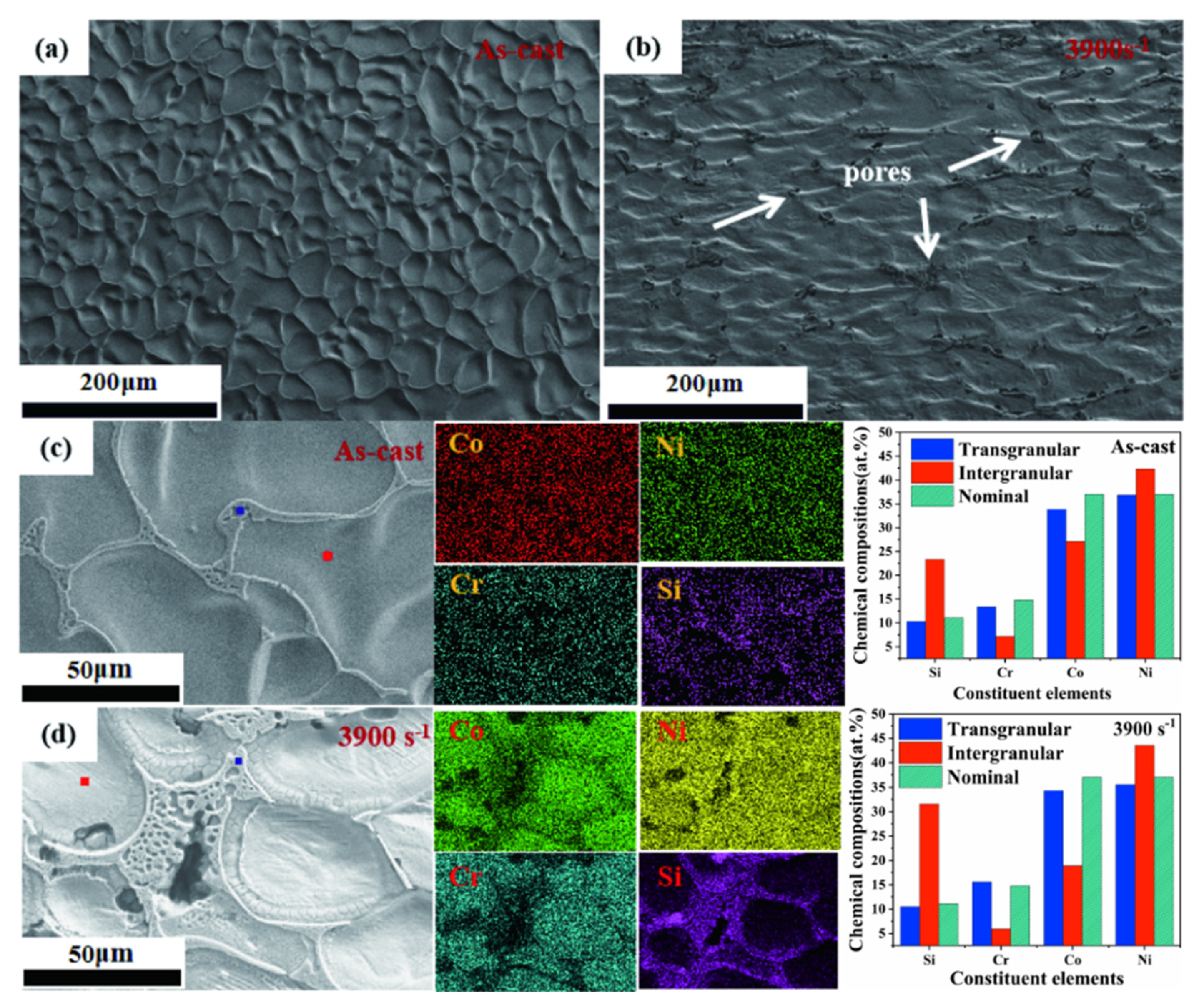
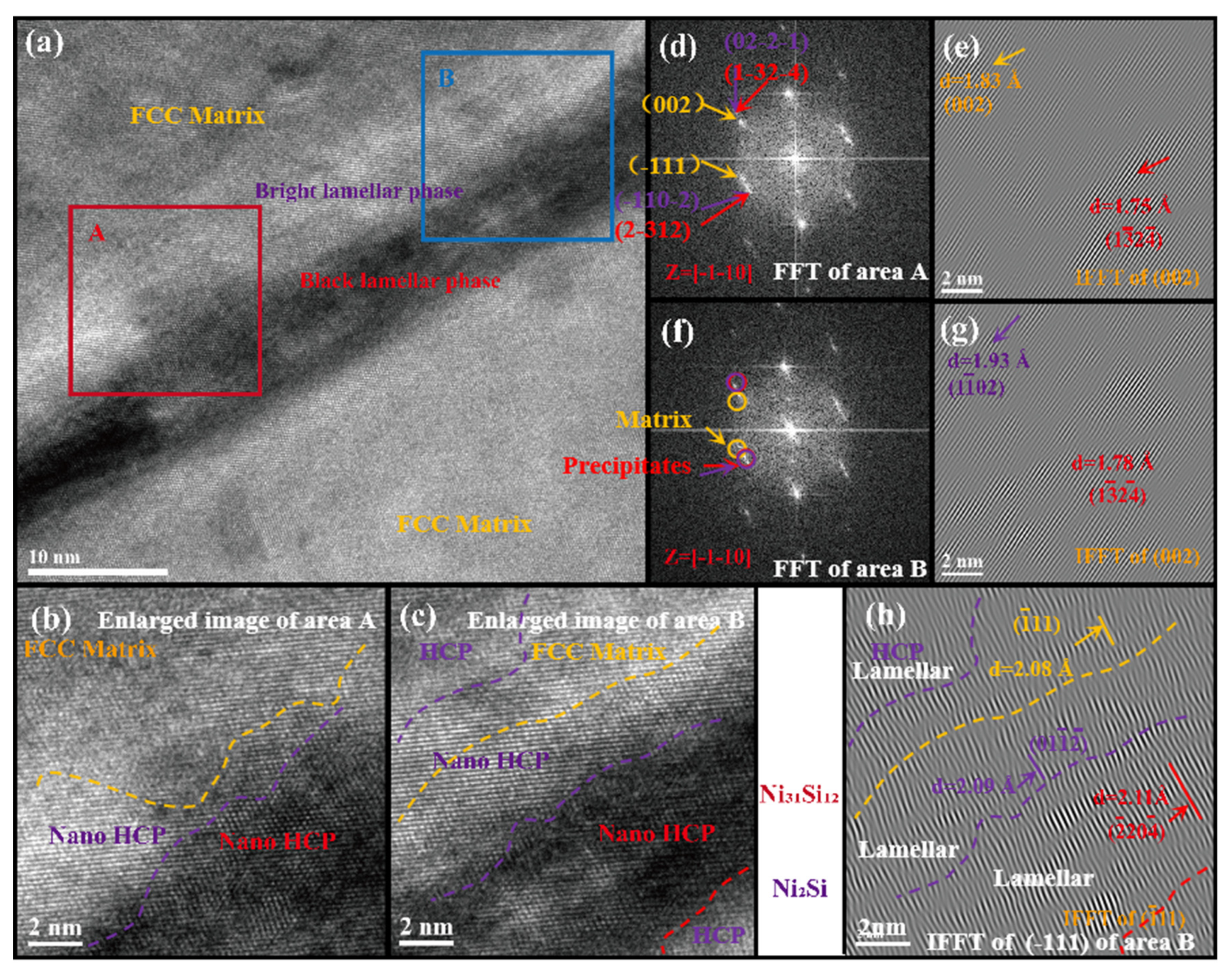
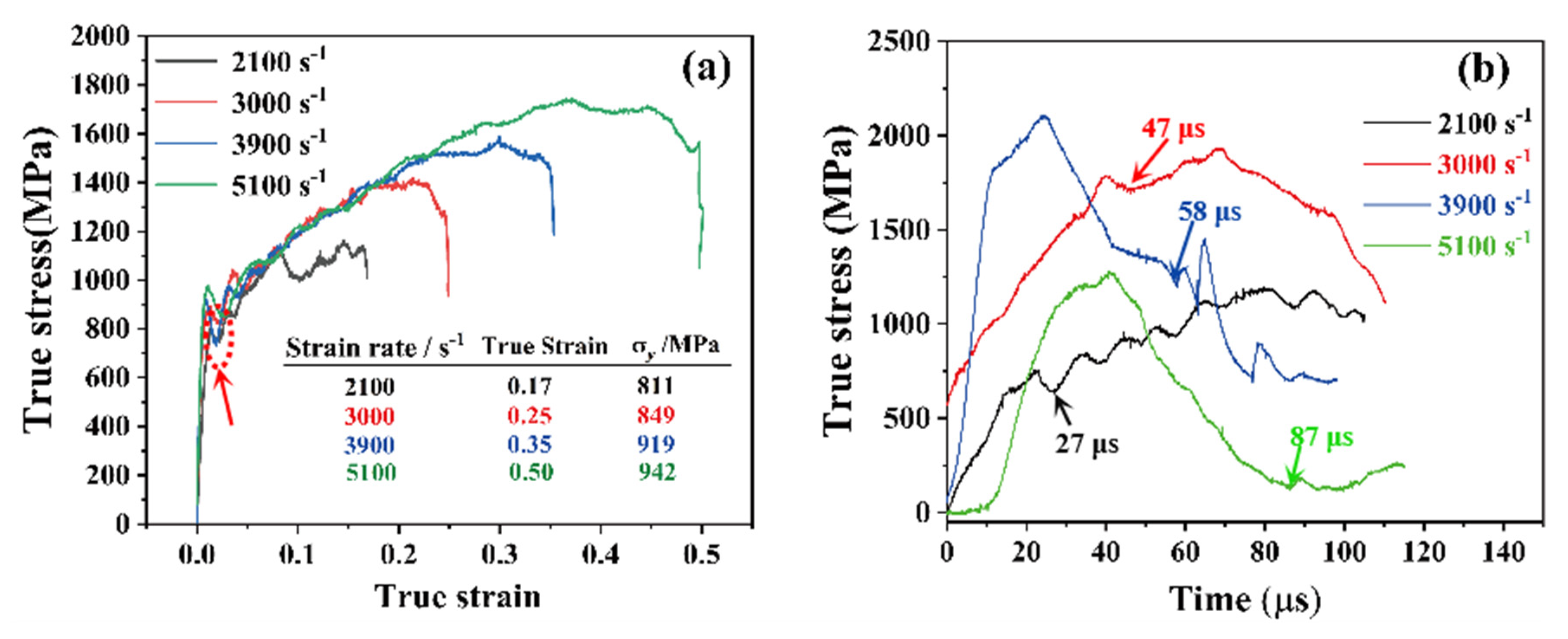
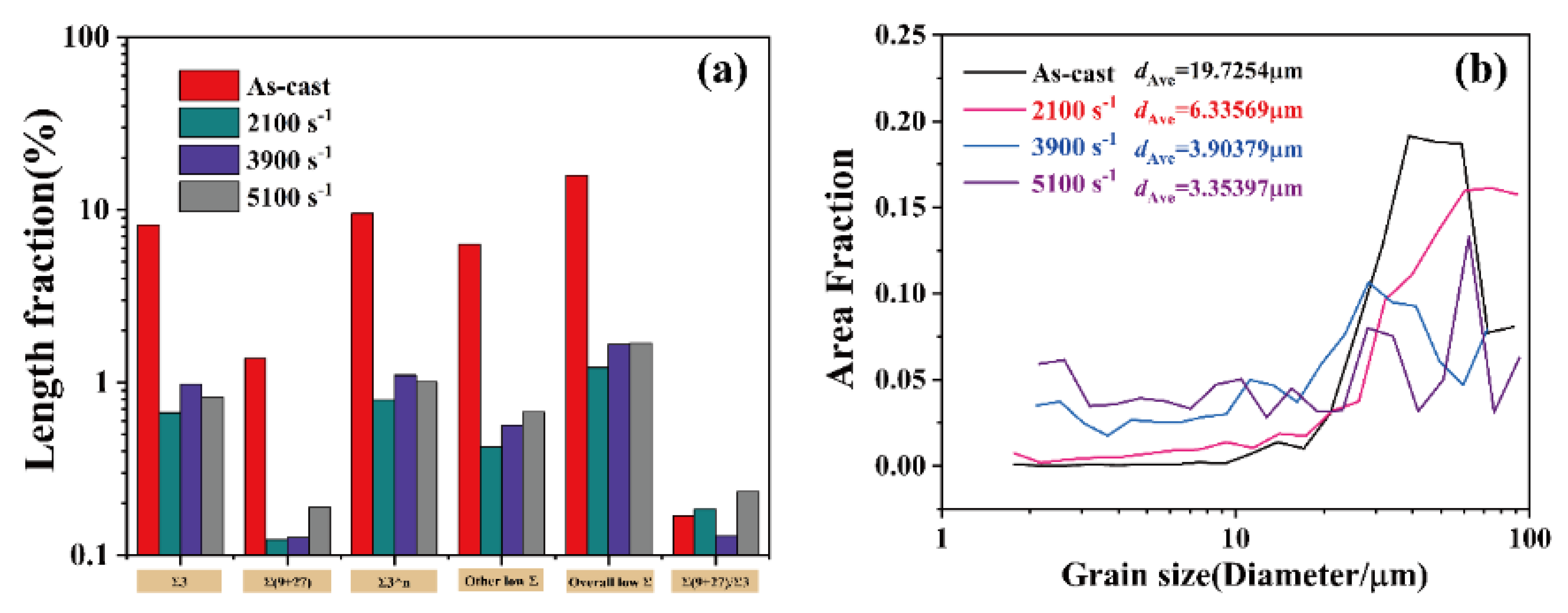
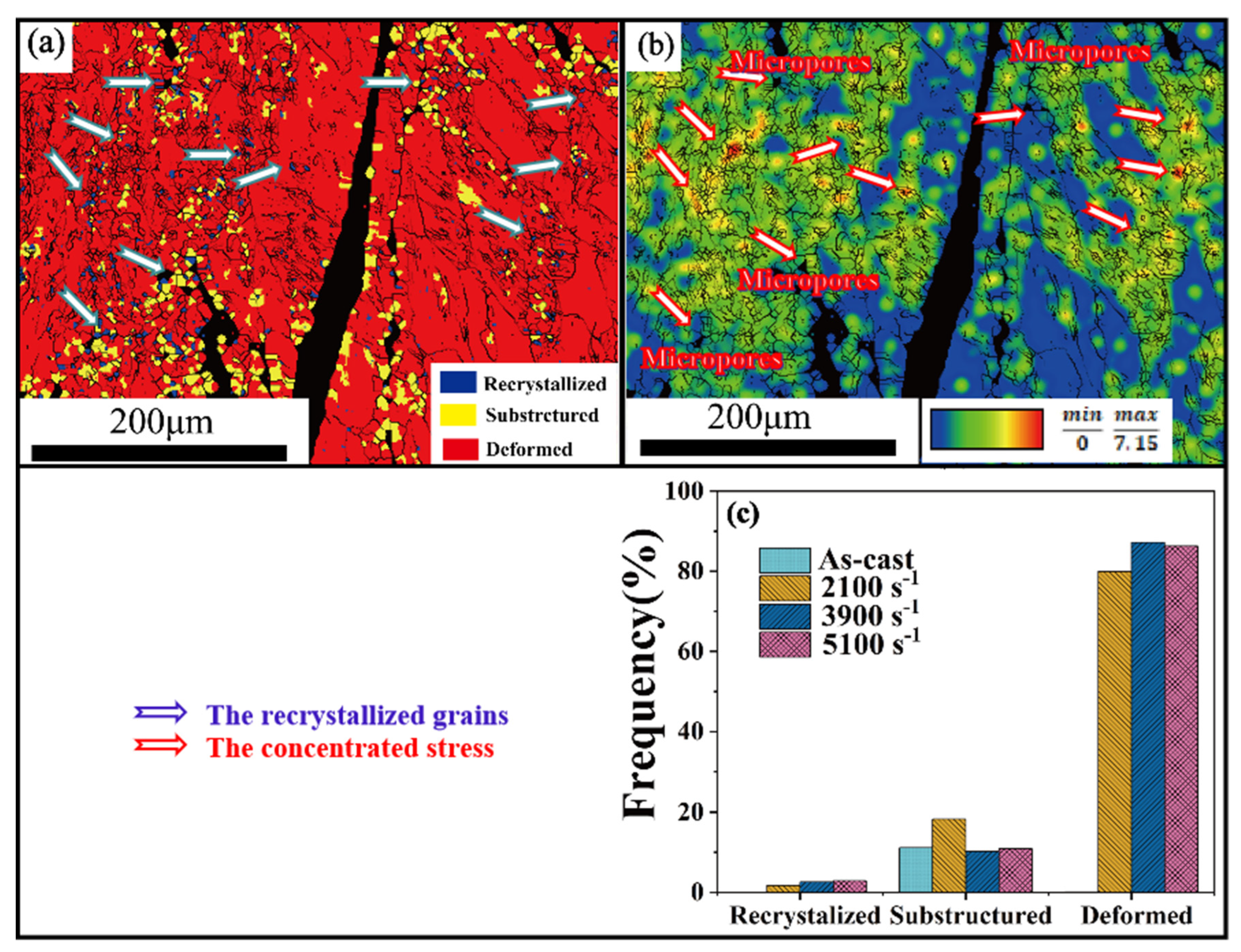


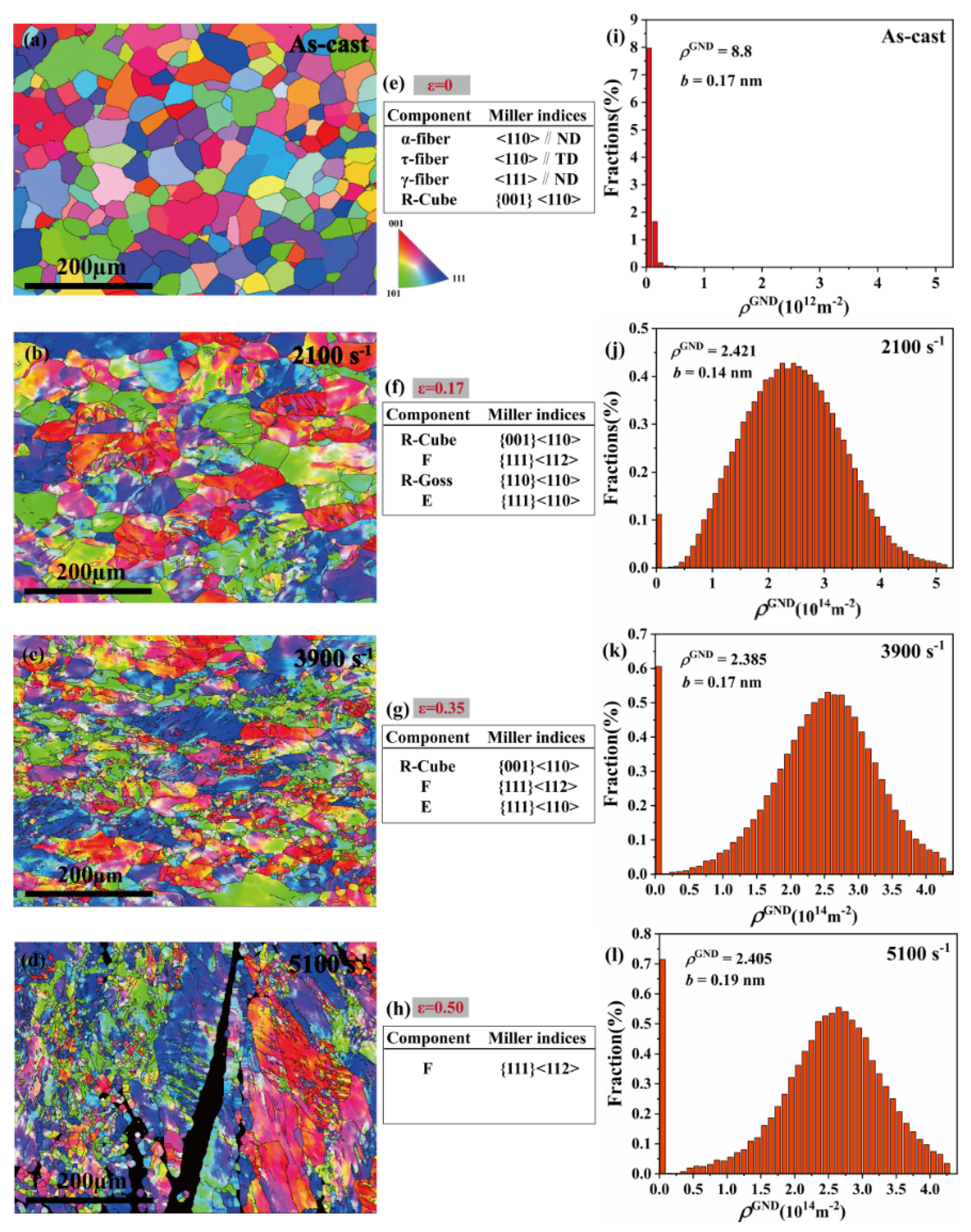
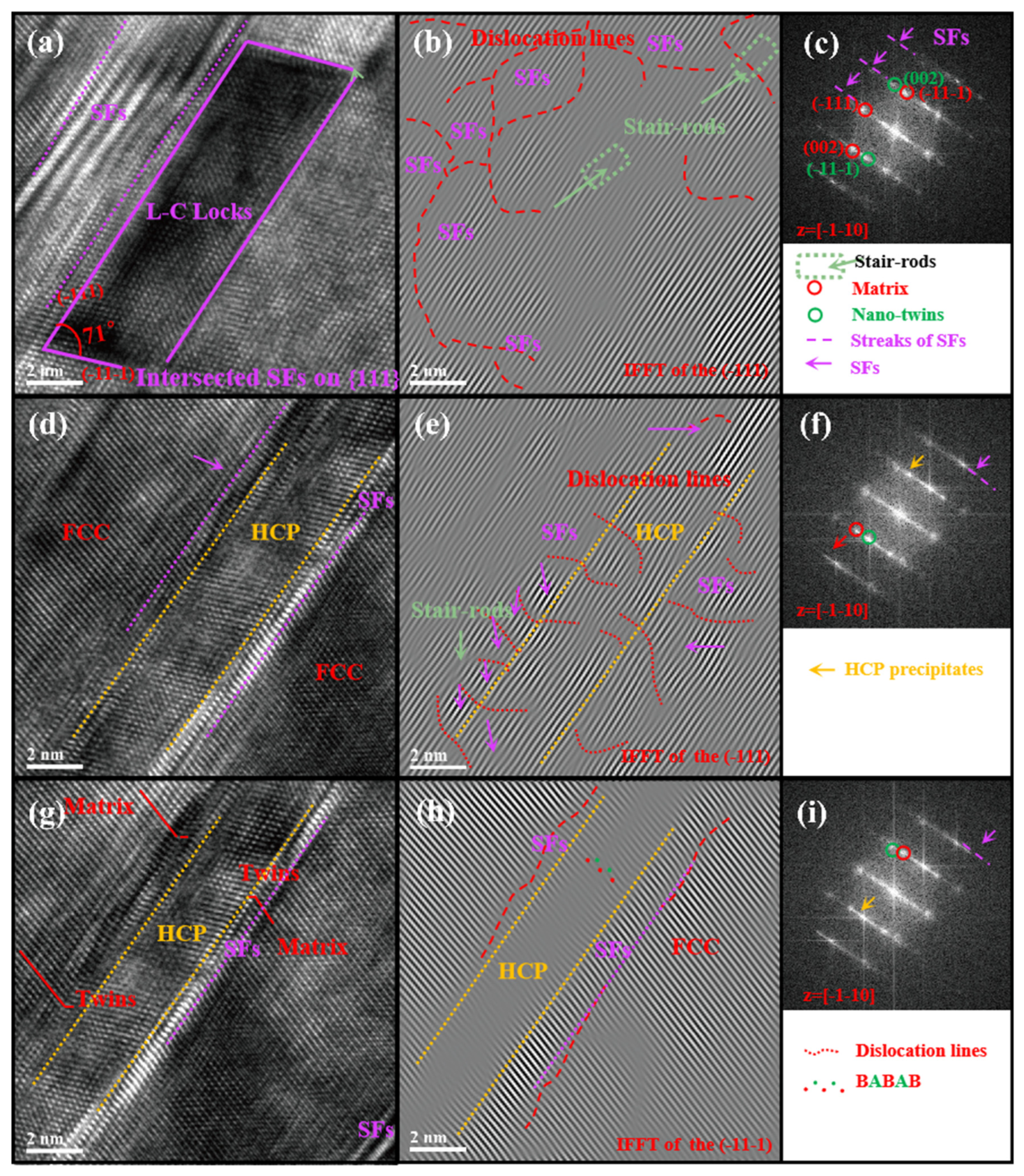
Disclaimer/Publisher’s Note: The statements, opinions and data contained in all publications are solely those of the individual author(s) and contributor(s) and not of MDPI and/or the editor(s). MDPI and/or the editor(s) disclaim responsibility for any injury to people or property resulting from any ideas, methods, instructions or products referred to in the content. |
© 2023 by the authors. Licensee MDPI, Basel, Switzerland. This article is an open access article distributed under the terms and conditions of the Creative Commons Attribution (CC BY) license (https://creativecommons.org/licenses/by/4.0/).
Share and Cite
Zhang, L.; Zhang, W.; Chen, L.; Li, F.; Zhao, H.; Wang, X.; Zhou, G. Microstructure and Texture Evolution of a Dynamic Compressed Medium-Entropy CoCr0.4NiSi0.3 Alloy. Crystals 2023, 13, 1390. https://doi.org/10.3390/cryst13091390
Zhang L, Zhang W, Chen L, Li F, Zhao H, Wang X, Zhou G. Microstructure and Texture Evolution of a Dynamic Compressed Medium-Entropy CoCr0.4NiSi0.3 Alloy. Crystals. 2023; 13(9):1390. https://doi.org/10.3390/cryst13091390
Chicago/Turabian StyleZhang, Li, Weiqiang Zhang, Lijia Chen, Feng Li, Hui Zhao, Xin Wang, and Ge Zhou. 2023. "Microstructure and Texture Evolution of a Dynamic Compressed Medium-Entropy CoCr0.4NiSi0.3 Alloy" Crystals 13, no. 9: 1390. https://doi.org/10.3390/cryst13091390




